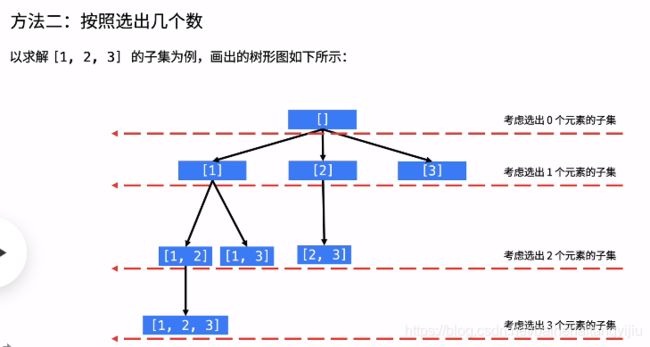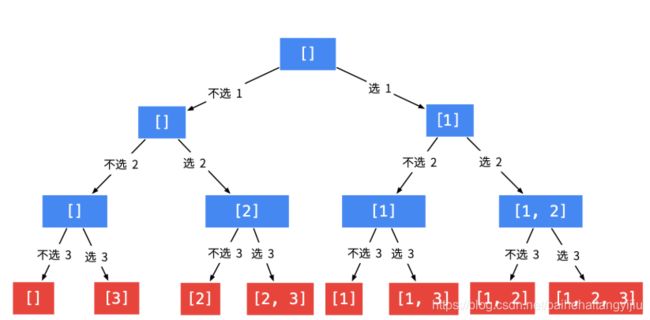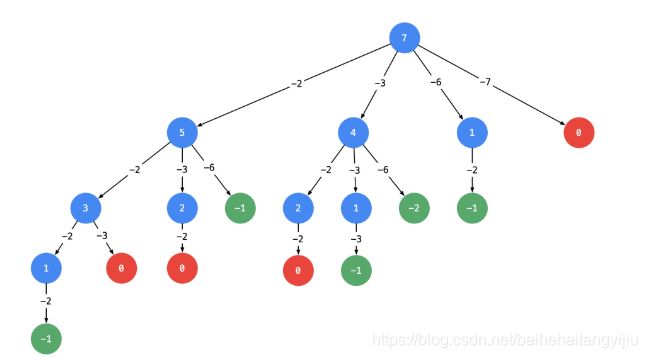78. 子集_39. 组合总和_46. 全排列
总结:
for(int i = begin; i < nums.length; i++) {
dfs(i+1) // 1,2,3; 2,3; 3 回溯过后,也要接着向后 78.子集
}
for(int i = begin; i < nums.length; i++) {
dfs(i) // 1,1,2; 2,2,3,4;... 元素可以重复,全局不重复靠顺序,即回溯时for的i++ 39.组合总和
}
for(int i = 0; i < nums.length; i++) {
if(!used[i]) {
dfs(depth+1,) // 元素不重复靠used, 全局不重复靠顺序,即回溯时for的i++ ,46. 全排列
}
}
不同:
每种元素只出现一次:for(int i = begin,) path.add(nums[i]); dfs(nums,i+1)
每种元素出现次数不限制:for(int i = begin,) path.add(nums[i]); dfs(nums,i)
相同:
-
不重复,即即[1,2] [2,1]算一种,按顺序添加元素,可以不重复
for(int i = begin; i < nums.length; i++); 当回溯到上一层时,上一层之前的选过的就不能选,因为i会++;从上一次选的后一个元素开始选。
其实是:按顺序取,只会出现[1,2],最终答案只会出现[1,2]这个答案。 -
48全排列,for(int i = 0; ) 每次不会从i+1开始选,而是三个都可以选,used保证不重复
-
保证全局不重复,都是采用一个思想,for(int i = ) 回溯到上一层后,之前选的不选,
每种元素值出现一次,不同顺序算重复:78子集
- for循环和没有for循环,进入下一层i+1,和index+1的注意点。
每种元素出现多次,不同顺序算重复:39.组合总和
- 48全排列,用used保证
横向比较
nums = [1,2,3,4,5] nums.length = 5;
第一种情况:参考78.子集
要求:每种元素最多只能出现一次;不重复(按顺序添加元素,可以不重复),即[1,2] [2,1]算一种;列出所有组合
-
每一层有多个选择,for
-
回溯,向上弹一层,需要丢失这一层的元素,path.pop();
-
为保证不重复性,需要保持顺序。对应:dfs(nums,index,path,res);
path.add(nums[i]);dfs(nums, i+1,path,res); --> for(int i = begin) index = index+1; -
每到达一个节点,path都是满足要求的。对应:在for里面res.add(new ArrayList(path));
-
回溯到上一层时,上次到达这层选择就能再选了,需要从他后一个开始选择;对应:dfs(nums,index,path,res);
path.add(nums[i]);dfs(nums, i+1,path,res); --> for(int i = begin) i = i++;
第二种情况:
要求:
78. 子集
给定一组不含重复元素的整数数组 nums,返回该数组所有可能的子集(幂集)。
说明:解集不能包含重复的子集。
示例:
输入: nums = [1,2,3]
输出:
[
[3],
[1],
[2],
[1,2,3],
[1,3],
[2,3],
[1,2],
[]
]
class Solution {
public List<List<Integer>> subsets(int[] nums) {
// 第一层:nums.length个选择
// 按顺序深入下一层,
// 回溯时,之前选择的不选择
List<List<Integer>> res = new ArrayList<>();
Deque<Integer> path = new ArrayDeque<>();
dfs(nums, 0, path, res);
return res;
}
private void dfs(int[] nums, int begin, Deque<Integer> path, List<List<Integer>> res) {
res.add(new ArrayList(path));
for(int i = begin; i < nums.length; i++) {
path.addLast(nums[i]);
dfs(nums, i+1, path, res);
path.removeLast();
}
}
}
public class Solution {
public List<List<Integer>> subsets(int[] nums) {
List<List<Integer>> res = new ArrayList<>();
int len = nums.length;
if (len == 0) {
return res;
}
Stack<Integer> stack = new Stack<>();
dfs(nums, 0, len, stack, res);
return res;
}
private void dfs(int[] nums, int index, int len,
Stack<Integer> stack, List<List<Integer>> res) {
if (index == len) {
res.add(new ArrayList<>(stack));
return;
}
// 当前数可选,也可以不选
// 不选,直接进入下一层
dfs(nums, index + 1, len, stack, res);
// 选了有,进入下一层
stack.add(nums[index]);
dfs(nums, index + 1, len, stack, res);
stack.pop();
}
}
作者:liweiwei1419
链接:https://leetcode-cn.com/problems/subsets/solution/hui-su-python-dai-ma-by-liweiwei1419/
39. 组合总和
给定一个无重复元素的数组 candidates 和一个目标数 target ,找出 candidates 中所有可以使数字和为 target 的组合。
candidates 中的数字可以无限制重复被选取。
说明:
所有数字(包括 target)都是正整数。
解集不能包含重复的组合。
示例 1:
输入:candidates = [2,3,6,7], target = 7,
所求解集为:
[
[7],
[2,2,3]
]
示例 2:
输入:candidates = [2,3,5], target = 8,
所求解集为:
[
[2,2,2,2],
[2,3,3],
[3,5]
]
class Solution {
public List<List<Integer>> combinationSum(int[] candidates, int target) {
List<List<Integer>> res = new ArrayList<>();
Deque<Integer> path = new ArrayDeque<>();
dfs(candidates, 0, target, path, res);
return res;
}
private void dfs(int[] nums, int begin, int target, Deque<Integer> path, List<List<Integer>> res) {
if(target < 0) {
return;
}
if(target == 0) {
res.add(new ArrayList(path));
return;
}
for(int i = begin; i < nums.length; i++) {
path.addLast(nums[i]);
dfs(nums, i, target - nums[i], path, res);
path.removeLast();
}
}
}
剪枝:
根据上面画树形图的经验,如果 target 减去一个数得到负数,那么减去一个更大的树依然是负数,同样搜索不到结果。基于这个想法,我们可以对输入数组进行排序,添加相关逻辑达到进一步剪枝的目的;
排序是为了提高搜索速度,对于解决这个问题来说非必要。但是搜索问题一般复杂度较高,能剪枝就尽量剪枝。实际工作中如果遇到两种方案拿捏不准的情况,都试一下。
public class Solution {
public List<List<Integer>> combinationSum(int[] candidates, int target) {
int len = candidates.length;
List<List<Integer>> res = new ArrayList<>();
if (len == 0) {
return res;
}
// 排序是剪枝的前提
Arrays.sort(candidates);
Deque<Integer> path = new ArrayDeque<>();
dfs(candidates, 0, len, target, path, res);
return res;
}
private void dfs(int[] candidates, int begin, int len, int target, Deque<Integer> path, List<List<Integer>> res) {
// 由于进入更深层的时候,小于 0 的部分被剪枝,因此递归终止条件值只判断等于 0 的情况
if (target == 0) {
res.add(new ArrayList<>(path));
return;
}
for (int i = begin; i < len; i++) {
// 重点理解这里剪枝,前提是候选数组已经有序,
if (target - candidates[i] < 0) {
break;
}
path.addLast(candidates[i]);
dfs(candidates, i, len, target - candidates[i], path, res);
path.removeLast();
}
}
}
46. 全排列
给定一个 没有重复 数字的序列,返回其所有可能的全排列。
输入: [1,2,3]
输出:
[
[1,2,3],
[1,3,2],
[2,1,3],
[2,3,1],
[3,1,2],
[3,2,1]
]
class Solution {
public List<List<Integer>> permute(int[] nums) {
// 元素不能重复,used取过了,就不能再取了,当到达叶子节点时,添加结果
// 没有顺序,即[1,2,3] [2,3,1]是不同的:即每一层都要遍历所有元素,不能按顺序取for(int i = 0)
// 为了保证整体不重复,要顺序举例,for(int i = 0; i++)
List<List<Integer>> res = new ArrayList<>();
Deque<Integer> path = new ArrayDeque<>();
boolean[] used = new boolean[nums.length];
dfs(nums, 0, path, used, res);
return res;
}
private void dfs(int[] nums, int index, Deque<Integer> path, boolean[] used, List<List<Integer>> res) {
if(index == nums.length) {
res.add(new ArrayList(path));
return;
}
for(int i = 0; i < nums.length; i++) {
if(!used[i]) {
used[i] = true;
path.addLast(nums[i]);
dfs(nums, index+1, path, used, res);
path.removeLast();
used[i] = false;
}
}
}
}



